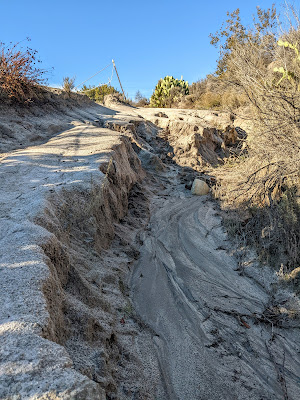On The Move: A Life and Proximity
Santiago Canyon Road is a remote highway that strings together two populace areas of Orange County. The Canyon feels like a portal to certainly another place, possibly another time. To drive the canyon is to leave one manicured strip mall city for another, but with a long sigh between of space and hills and horses and yards filled with project vehicles. It feels like a brief vacation from suburbia.
The road has a bike lane. Cyclists, aerodynamic as wasps, zip through the canyon nonstop. But there is no sidewalk and not much shoulder, so I won't run there, except for a several hundred yard exception. Rancho Las Lomas is an event center that maintains a small truck trail in front of their property. Tucked in a tunnel of live oaks and bushy hedges, this little stretch allows for a pleasant loop from the two ends of Ridgeline, the street that connects to my neighborhood.
Neurologist Oliver Sacks describes himself as a “physician, teacher and storyteller” in On The Move, his second memoir. Published months before his death, the book feels to be written in urgency but not in worry. There is much for Sacks to marvel at as his death approaches. Sacks scurries past critical points in his life in order to get to the pleasurable business of being filled with awe and gratitude.
I first heard about Sacks in graduate school when a professor told a class full of writing students, all obsessed with publication, about Sacks' strategy for finishing his first book. If the book wasn't done by a self imposed deadline, Sacks announced to himself, he would kill himself.
Sacks confirms this pact and its sincerity in On The Move. Thankfully he and the book, Migraine, survive publication. Twelve more books follow, mostly case studies about his patients. Also in On The Move, Sacks describes a publisher talking him down from infinite, manic edits to one of his books. The publisher saves Sacks from his "too-muchness."
Too-muchness is Sacks' baseline. All-nighters on his motorcycle during residency, back squats until both quadriceps tendons are torn, copious amounts of hallucinogens and uppers, incessant writing, are all in a month's work for young Sacks. Nothing is done in half measure. He has no ability to regulate. The writing that comes from this is wonderful.
On The Move is named for a poem by Thom Gunn, a friend whose writing and lifestyle Sacks admires. One thing Sacks loves about this friendship is that "we never knew where the conversation would go."
So it is with this book. On The Move is disjointed, unusual, and charming. Sacks bounces from topic to tangential topic in a way that only tracks in the way memory works. He rushes through his young private life in a way that is brisk but unguarded. He's not hiding, he's just not interested. There are other things to think about. His real interest is his work, his patients, and the ragtag of interesting people he collects through life.
Sacks approaches dying as he does every other stage of life: with
curiosity and fascination. Partially blinded by the cancer that will eventually kill him, Sacks is thrilled by the sensory adjustments his brain manages. His participation in the world is heightened at the end of
life. He feels more pain, more focus, and more love than ever before.
Sacks expresses a neutral awareness that he is odd, he fixates, he gets lost in his personal tunnels. Then, when he clears the obsession and lifts his head, he is amazed to find himself surrounded by sound and color and magic. His illness seems to yank him from the life he lives in parallel to the rest of us. He is dropped into the present tense to exist alongside steady and tangible objects and beings.
From the truck road you can see cars pass by on Santiago Canyon. But they can't see you. There's a sense of invisibility, and with that feeling comes a fraying of existence, as if nothing matters more than the roots below and leaves above. The path is a tiny parallel universe and then the ground turns to cement and the sky opens up. Here is the noisy world, and it is full of solid wonder, and it was so close all along.
I borrowed this book from my library via Libby. Read by Dan Woren, it is 11 hours and 53 minutes.



Comments
Post a Comment